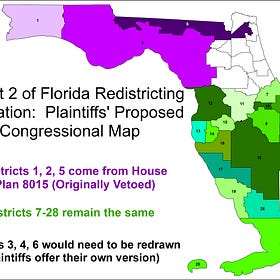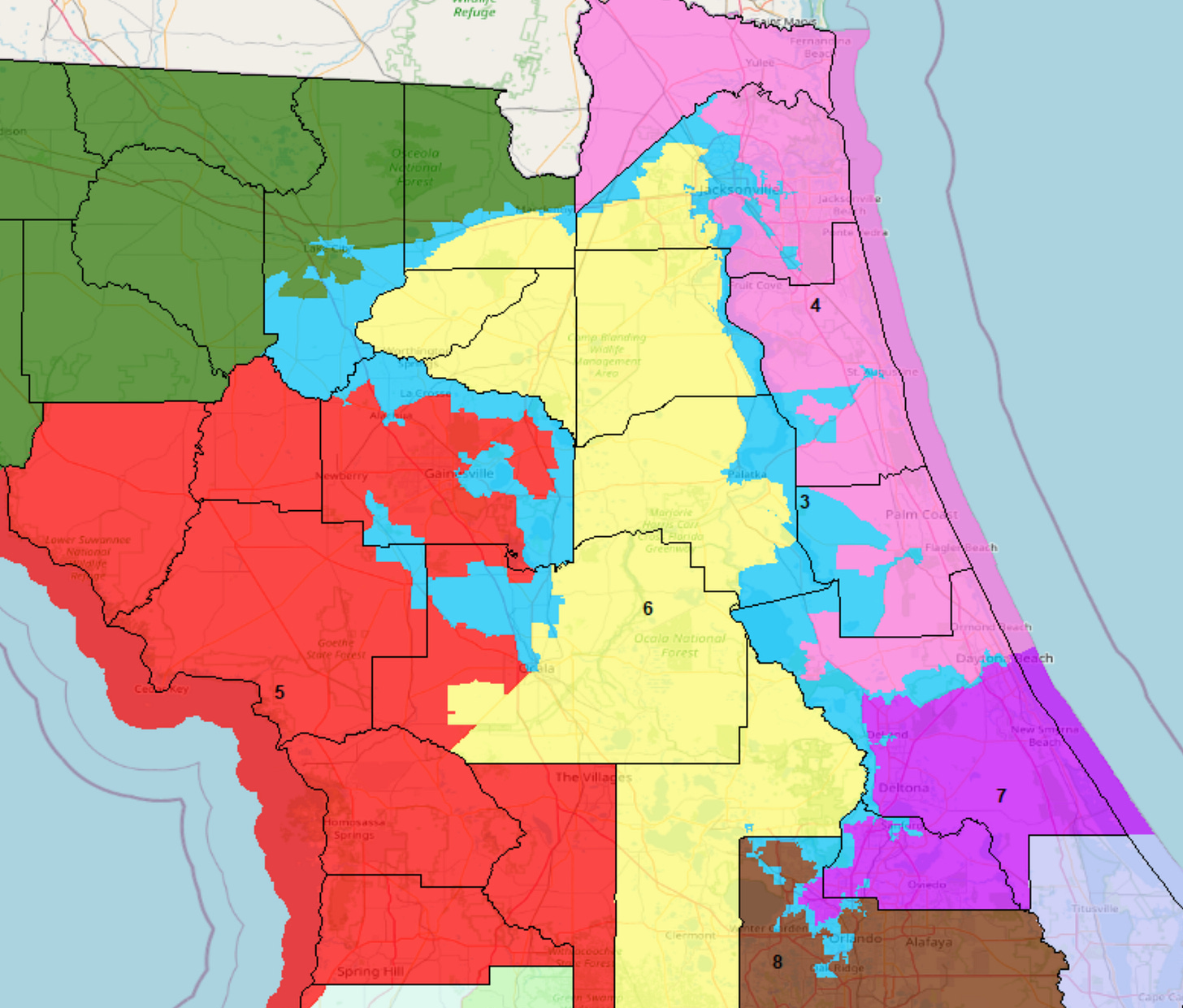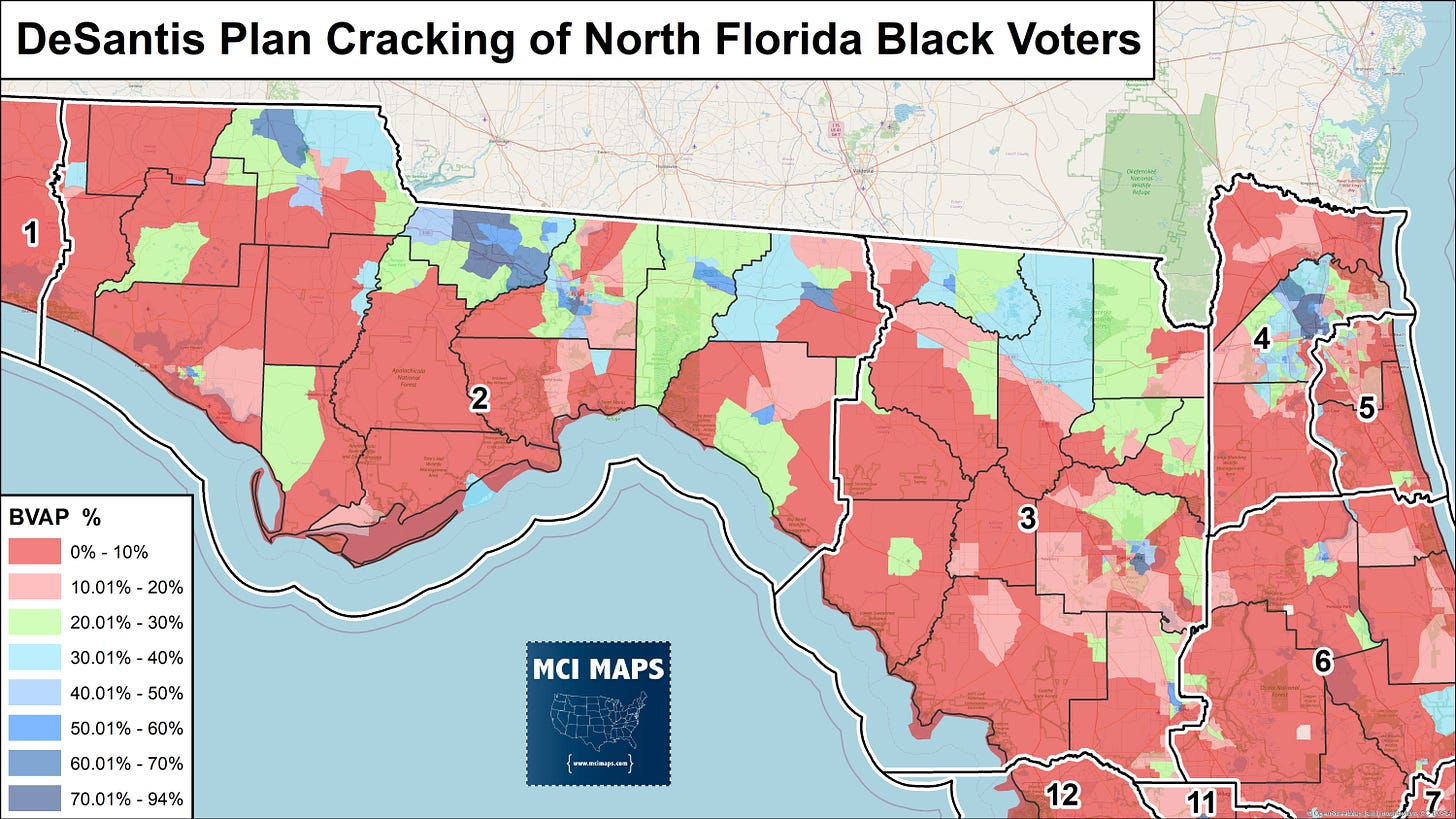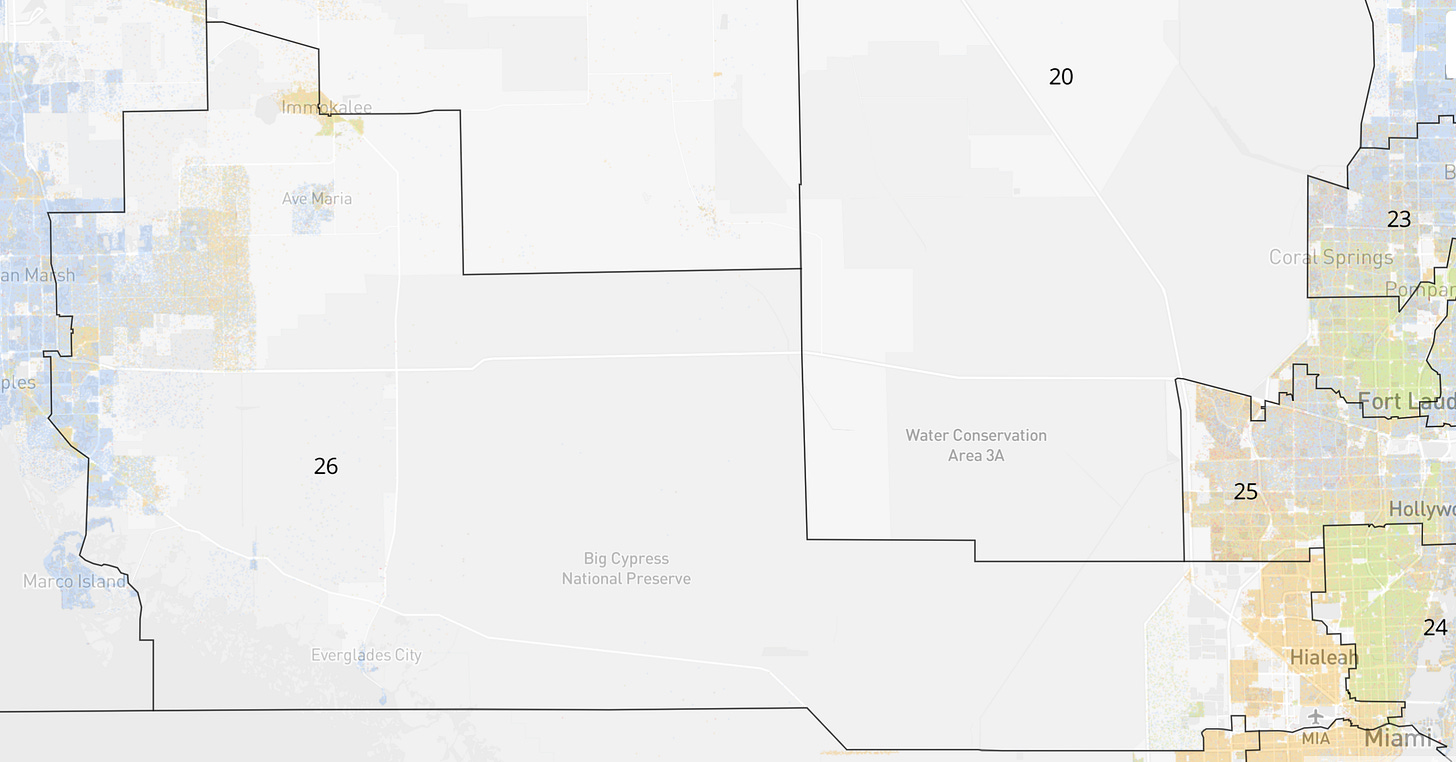Issue #125: Florida Government Struggles in Redistricting Trial
Judge Marsh seemed unamused with GOP talking points
Yesterday was the big day in Florida Court for redistricting. The lawsuit over the state’s Congressional map, which began last year after DeSantis rammed through a gerrymandered plan, finally reached a courtroom.
Just two weeks ago, the lawsuit narrowed considerably to focus just on North Florida. The suit specifically focused on the elimination of the 5th Congressional District, a black-access seat that went from Tallahassee to Jacksonville until 2022. I delved into the narrowing of the suit in this post below.
Issue #123: Florida's Redistricting Battle Narrows to the FL-05
Florida’s redistricting saga has taken a major left-turn in the past few days. Initially, a trial was expected to start on August 21st in state court over the Congressional map that Ron DeSantis rammed through the Florida legislature. One major item the lawsuit focused on the destruction of the 5th Congressional district, which was initially drawn to …
That post includes many important details, including the redistricting history in Florida. If you need a refresher on the timeline, I recommend that read. The long story short for this case is as follows.
The plaintiffs argued that eliminating the 5th district, which resulted in North Florida not having a black-performing seat for the first time since 1992, violated the rules against racial retrogression under Fair Districts; the constitutional amendments passed by voters in 2010.
The state, as part of the narrowing of the case, agreed that the removing of the 5th DID violate Fair Districts. However, they claim that drawing such a district in North Florida violates the Equal Protection clause of the 14th amendment.
The hearing in court yesterday centered around this debate. It was also agreed that any side wishing to appeal would go right to the Florida Supreme Court. The parties presented their arguments before Judge James Lee Marsh, a Rick Scott appointee.
The hearing went a great deal better for the plaintiffs than it did for the state. Lets delve in.
The Arguments
The plaintiffs were in a much stronger legal position before the court. They were in the prime position to largely argue that the Florida Government should follow the Florida laws. This would mean brining back the east-west, black-performing 5th, as its removal was as a clear violation of Fair Districts - something both sides stipulated too already.
However, since the state was arguing federal issues, the plaintiffs delved into what type of maps would be racial gerrymanders in the eyes of the US Supreme Court.
When does a 14th Amendment Argument Come into Play?
The state’s main point is the old 5th violated the 14th amendments equal protection provision by being a district where race is the predominant reason for drawing the lines. While the federal courts have made it clear that race can be a factor in district lines, it cannot be the sole justification. Districts that have been struck down on this issue can be seen below.
Here is the original 1992 CD3, which was drawn to be a North Florida black-performing seat.
And here is a 1992 State Senate district, which was likewise drawn to give black voters the ability to elect a candidate of their choice.
The courts found districts like this to be illegal, as race was the clear sole reason for their shapes.
The Lines of the Old 5th
The state has argued that the 5th district falls into this category of gerrymanders. The plaintiffs disagree; pointing out that in many/most of the drafts initially considered by the legislature for an east-west 5th, the borders of the district stuck to major roads whenever possible. In fact, the data shows that the lines for a proposal from the House (before DeSantis vetoed it) only had 2% of its lines not following major geographic boundaries.
When the state offered its defense, they aimed to paint the story of the 5th district as an unwieldy district that had no logic in its lines OTHER than race. They talked about the version of the 5th that was passed in 2015. For example, here is how Leon County was divided by the 2015 districts (blue is CD5, red is CD2).
Indeed, these are crappy lines. However, why were they this way? They actually did not need to be this ugly.
The 5th district approved in 2015, and I recommend reading my story of that remap here for a refresher, easily performed for black voters. The lines were drawn with race as a major factor. However, the story is trickier. These lines came from a draft drawn by a plaintiffs that year that the Florida Supreme Court cited as an acceptable alternative. The legislature opted to take the exact district and make it part of their remedial map. Efforts to change or smooth out lines in the cities were rejected by the legislature. These lines are a result of GOP leaders in the House and Senate refusing to make any alterations, even minor ones. These are the same lines the state, still run by the same party, is now attacking.
Now lets compare the 2015 CD5 to the draft that initially came out of the Florida House (and later vetoed) last year. I overlaid the two. Purple means both the 2015 and 2022 versions were the same, red means land was lost, and blue is land gained.
The lines approved by the House evened out many of the jagged borders. The new lines would have followed the major roads far better.
The state spent a great deal of time arguing about the jagged lines of the old district, but conveniently ignored the 2021 and 2022 drafts that cleaned the lines up much more.
Race Consciousness vs Race Predominance
A key point of the plaintiff case was that race CAN be part of a redistricting map. Race predominance, which we saw with many 1990s districts, is a problem because of how unclear district borders are. Those districts have no true identity beyond race. However, race consciousness has been legally acceptable for decades. This was even highlighted in the recent Alabama redistricting case, which saw the US Supreme Court order the state to draw a 2nd black-performing district. Race can be a factor, especially in regions where racist sentiment is historic and still remains.
That Alabama ruling came up in the court proceedings as well. Read here for my take on what it could mean for Florida. I pretty much predicted it would be a positive development or the plaintiffs.
For North Florida, this idea of racial consciousness clearly applies. The mutual agreement both sides laid out a few weeks ago even admits to the issues with racial polarization in North Florida. Granted, it seemed the state went back on that admittance, as their court briefs saw them claim North Florida did not have discriminatory sentiment.
This is truly a priceless claim considering studies that BOTH SIDES AGREED TO BEFORE TRIAL show that racial polarization is still a real issue in the region. The history is also well documented. In the past few weeks I wrote about the struggle for Voting Rights in North Florida and my Patreon has a story about the fight for black representation in Liberty County.
To go even further back, as I have discussed many times, this region was also the home to the large plantations of North Florida.
This large slave population is why Gadsden is the lone majority-black county in Florida. It is also why the North Florida region still has a large number of black residents. Contrary to the state’s claim, the district is not just about Tallahassee and Jacksonville. Rather, it would include rural black voters, many who trace their ancestry to slavery.
Here is how race looks in the panhandle, with the current Congressional lines showing how the population was cracked.
As the state stipulated in the joint agreement, the current lines do not allow black voters in North Florida to elect a candidate of their choice.
Now the state’s argument is that they cannot draw an east-west district again, as it would violate federal law.
Let me explain why they are hypocrites.
The State’s Hypocrisy
To listen to the state’s lawyers, you’d think they were being asked to draw one of those old 1990s districts. However, that aside, it must be remembered that for much of the 2021-2022 redistricting session, the legislature consistently said they believed an east-west 5th was needed. They passed several drafts with such a district, and it was only the Governor getting involved that ended that.
But after all that, the current maps hold plenty of districts that would, in theory, violate the state’s own arguments about the 5th.
Lets look at the 20th district. This seat, meant to be black-majority when you include Hispanic Blacks, heavily uses race to justify its borders.
The district aims to connect the black populations in Broward and Palm Beach counties. The inland population that isn’t right by Lake Okeechobee is almost entirely empty. These dense black populations are only connected by Everglades land.
Now to be clear, I am 10000% good with these lines. The interest of giving black residents in the area a voice is valid and I wouldn’t change it. However, the state is now claiming that is ok but an east-west 5th isn’t.
And to be clear, this is not about the fact this would be majority-black and the 5th wouldn’t be. An east-west 5th could be just a few % less black than the 20th, and most importantly it would perform for black voters, giving them control of the elections there. Courts in both state and federal jurisdictions have pointed out 50%+ is not automatically needed for a district to be considering a minority-performing seat. The 5th district was not majority-black but clearly showed black voters could elect a candidate of their choice.
On the legislative side, and right in the Tallahassee area, we have the 8th State House district. This seat covers all of Gadsden and the black communities of Tallahassee. It creates a seat that is 49% black.
As you look at the Tallahassee lines, there is clear consideration for race.
And again, this is 100% good with me. However, these lines are very similar to what a CD5 line would look like in Tallahassee.
The legislature claims that the land between Tallahassee and Jacksonville is low populated and rural. That is true - any east-west 5th would be dominated by the two cities. However, the idea the legislature is concerned about this is laughable when we look at their other lines. Below is the Southeast Florida region, with a dot map for voters by race overlaid.
Both the 20th and 26th see populations connected by empty Everglades land. If you wanted to drive from one end of the 26th to the other, it would take you around two hours. The state, meanwhile, claims that the 2+ hour drive time for an east-west 5th is too long.
The plaintiff attorneys pointed this fact out in the hearing - that the state is being inconsistent and selective with its logic.
How is Judge Marsh Going to Rule?
If I am a betting man, I put my money on Judge Marsh siding with the plaintiffs. Several things Judge Marsh said stuck out to me, as well as his overall mood.
He interrupted the state far more than the plaintiffs, peppering them to explain some of their conclusions.
He directly questioned the idea that he could overturn the precedent set by the Florida Supreme Court back in 2015.
He took issue with the state arguing that any remedy plan would be unconstitutional.
He directly called out the state’s attorney’s for clearly setting up an argument hoping the FL Supreme Court would side with them.
He questioned why the FL Attorney General was not there to defend the map in court.
The overall mood of the court was that Marsh was far less sympathetic to the arguments the state brought forward. He seems very unwilling to overrule the FL Supreme Court precedent - which specifically sited the east-west 5th as a viable option. He did express overall frustration that the originally-planned two week trial over the entire map got narrowed to one day after the 5th. He felt a longer trial would give more data/evidence for the inevitable trip to the Florida Supreme Court.
Now I have talked before about how the current top court is much more conservative, so I am not saying they can’t override a past decision. However, they have yet to do so, and Judge Marsh clearly is unwilling to rule the 2015 court was wrong in signing off on such a district.
Both sides have been given until COB Wednesday to submit final arguments in writing. Marsh said he intends to take that Thursday and Friday to dig into everything and formulate a ruling. That means we could get a ruling late next week, or beginning of the next.
The Florida Supreme Court will be the big test. A Marsh ruling for the plaintiffs here, however, would matter a great deal. As I told the local NPR station earlier this week, the plaintiffs would have little shot with the FL Supreme Court if they lost at this trial. A victory here is critical, as it gives the conservative-minded top court an easier out to not overturn precedent, side with restoring the 5th, and leaving the rest of the gerrymander intact.
We will see how Judge Marsh rules. However, if I’m the plaintiff’s attorney’s, I have to be feeling pretty good about how yesterday went.













